Abstract
The use of fluorescent probes to give continuous readouts of the structural states of mitochondrial membranes during energy coupling seems a logical extension of their use in the study of protein structural changes. A clear correlation of the probes' fluorescence characteristics with the acquisition of energy coupling can be demonstrated in fragmented and natural membrane using 1-anilinonaphthalene-8-sulfonate (ANS) and ethidium bromide respectively. The present contribution attempts to bring together contemporary viewpoints of this and other laboratories and the recent experimental data and give some detailed information on probe environment and on the structural or charge changes occurring upon energization.
The energy-dependent region of the membrane is located at an aqueous interface between an outer layer of proteins (presumably cytochromes) and the membrane permeability barrier; the aromatic portion of ANS appears to be located in the lipid phase and the sulfonic acid group in the aqueous phase. The aqueous phase is probably a structured water region near paramagnetic membrane components such as cytochrome. Membrane energization arising from altered redox potential changes of cytochromes (bT) is communicated to the water structure through altered structural states of the hemoproteins, causing a decreased volume of the structured water region and increased interaction with the paramagnetic components in the energized state. Attendant alterations of protonic equilibria of membrane components induce both local and transmembrane changes in charge distribution, with consequent movements of ions, including the probe molecules themselves.
Full text
PDF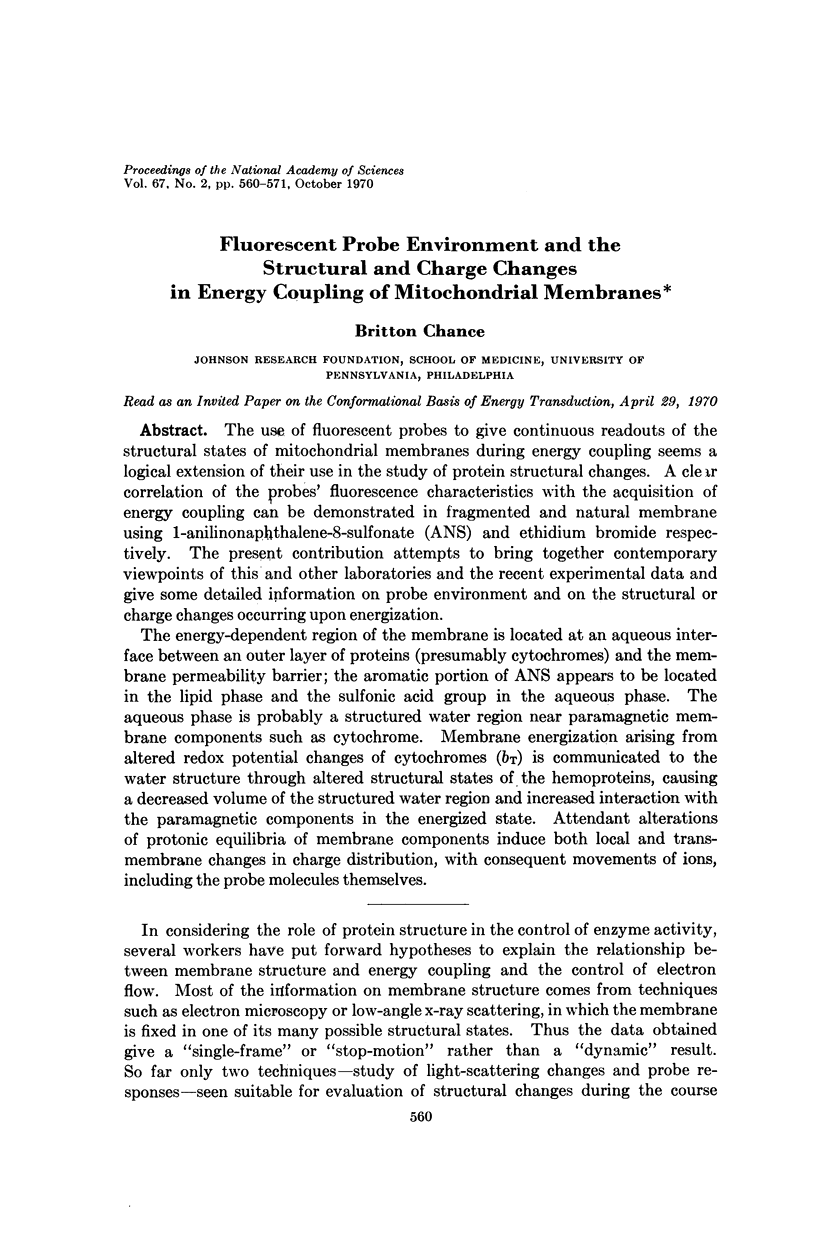
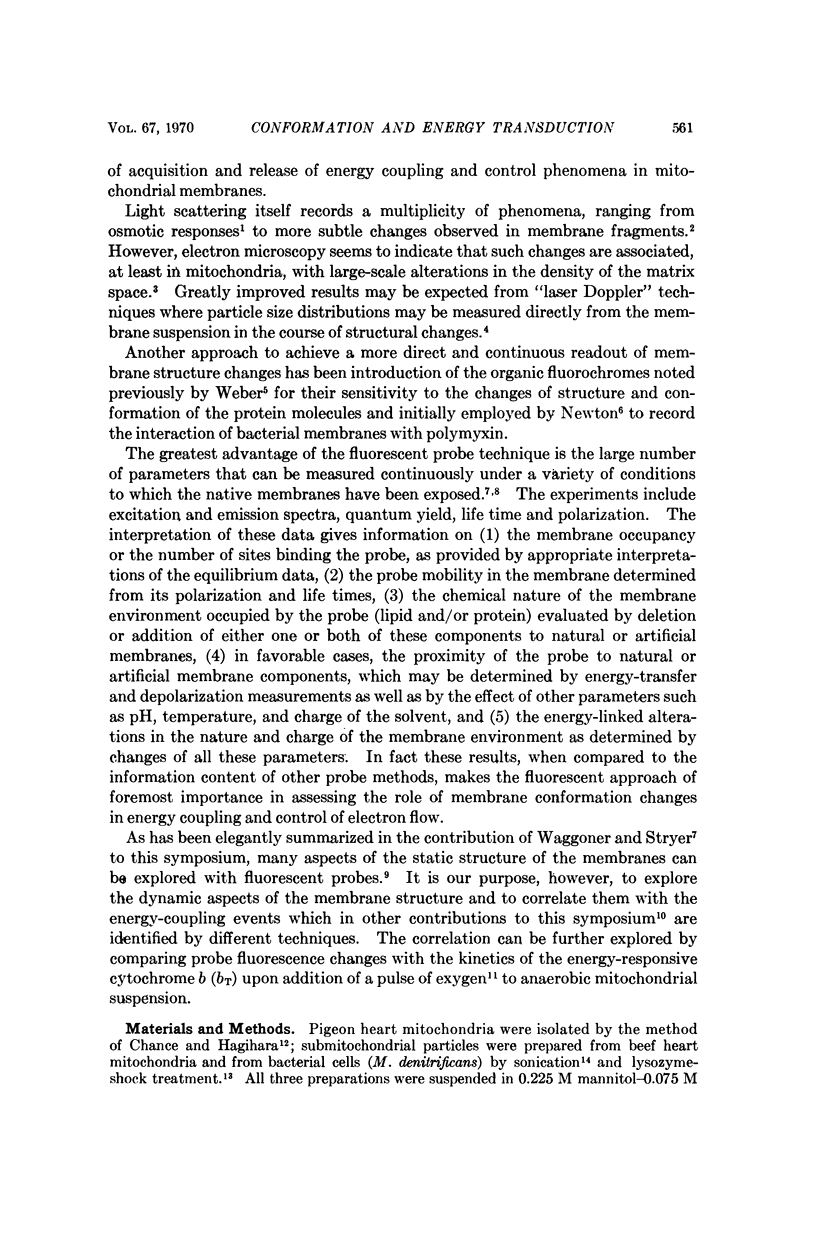
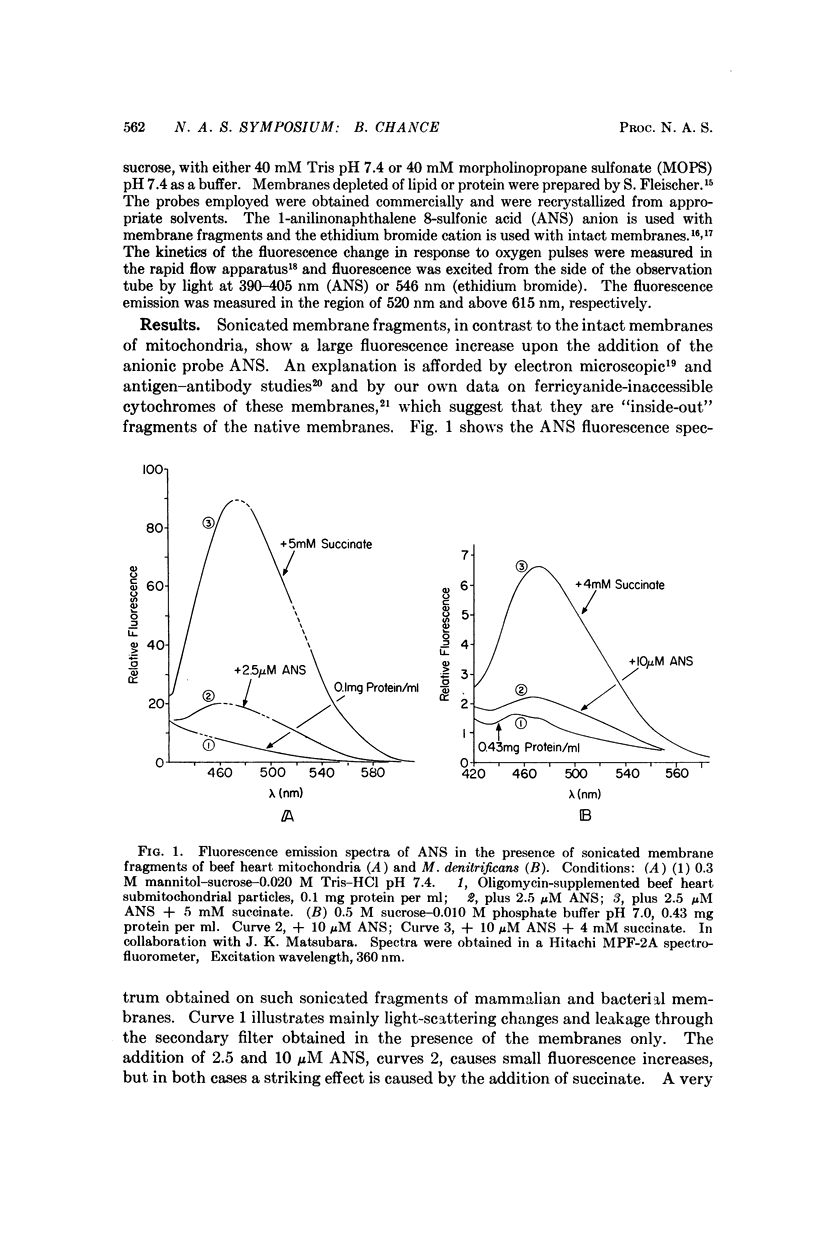
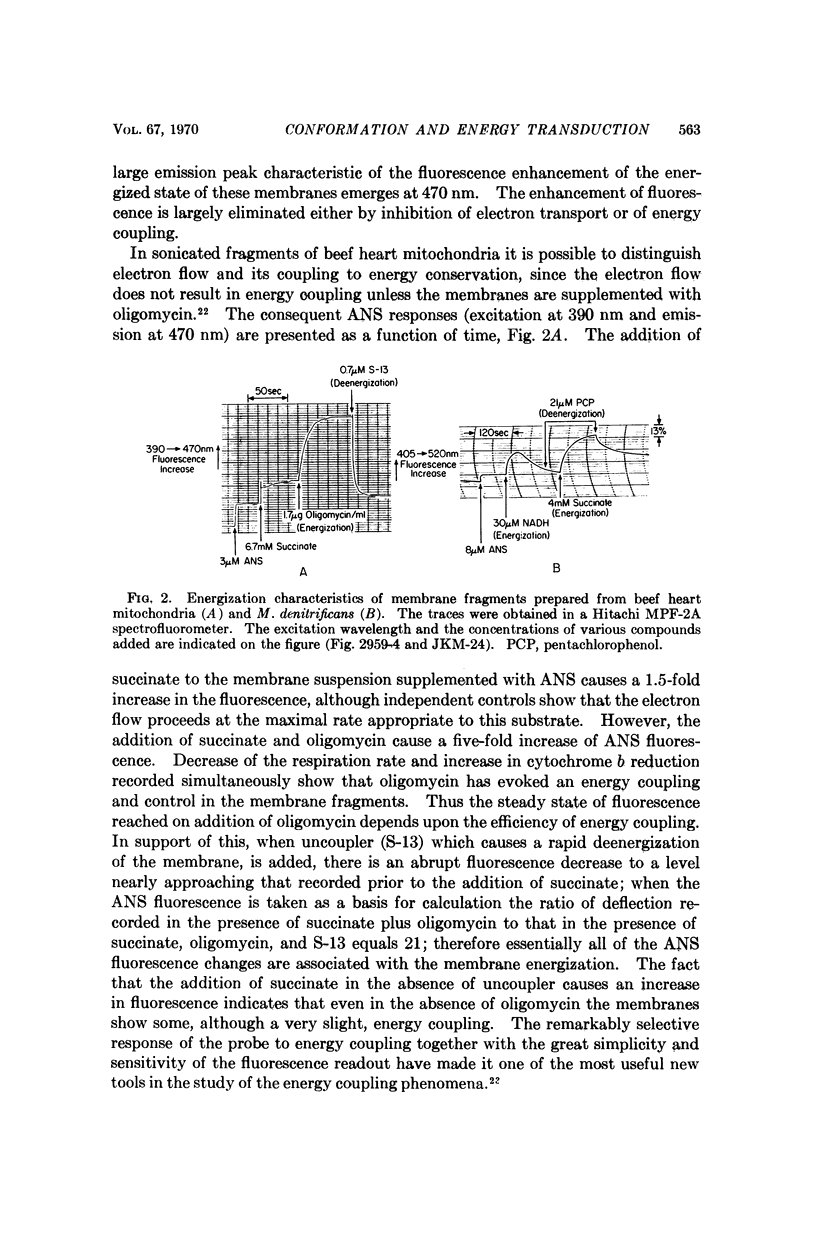

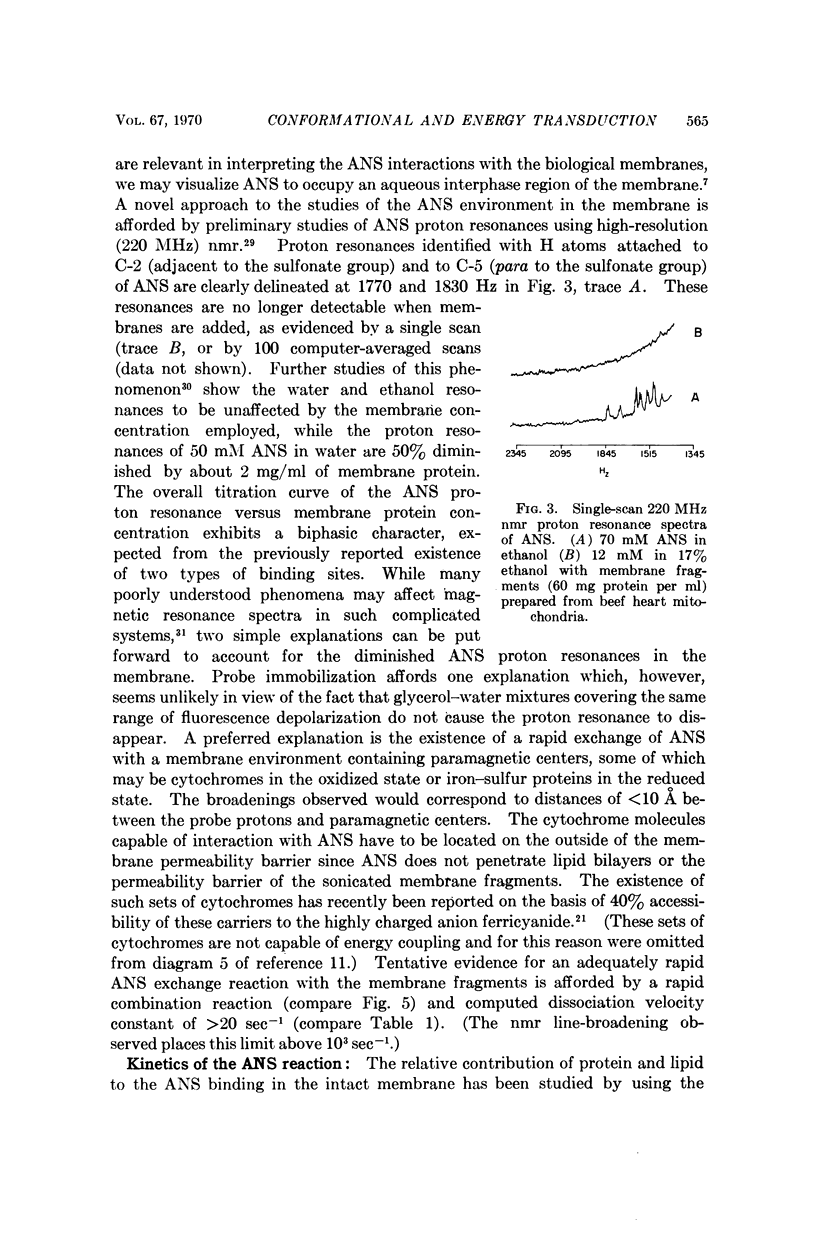
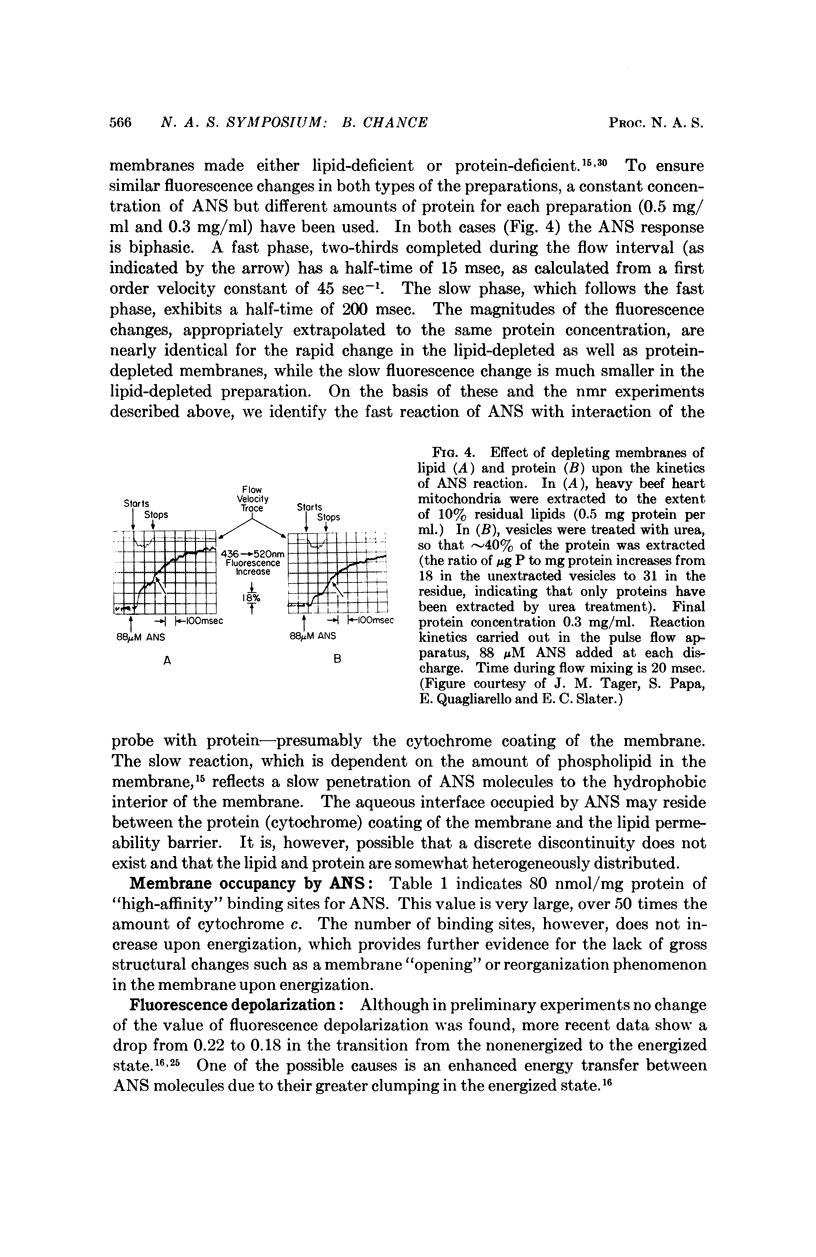

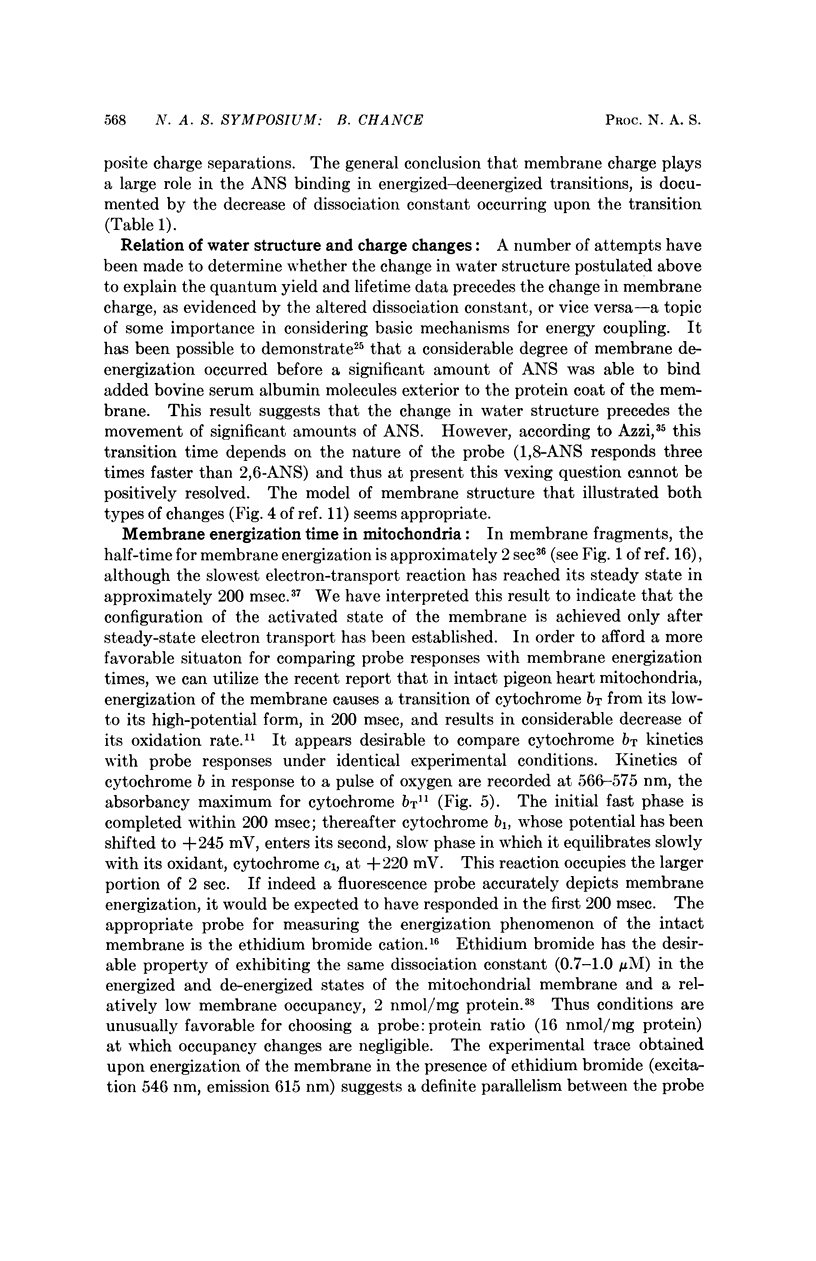
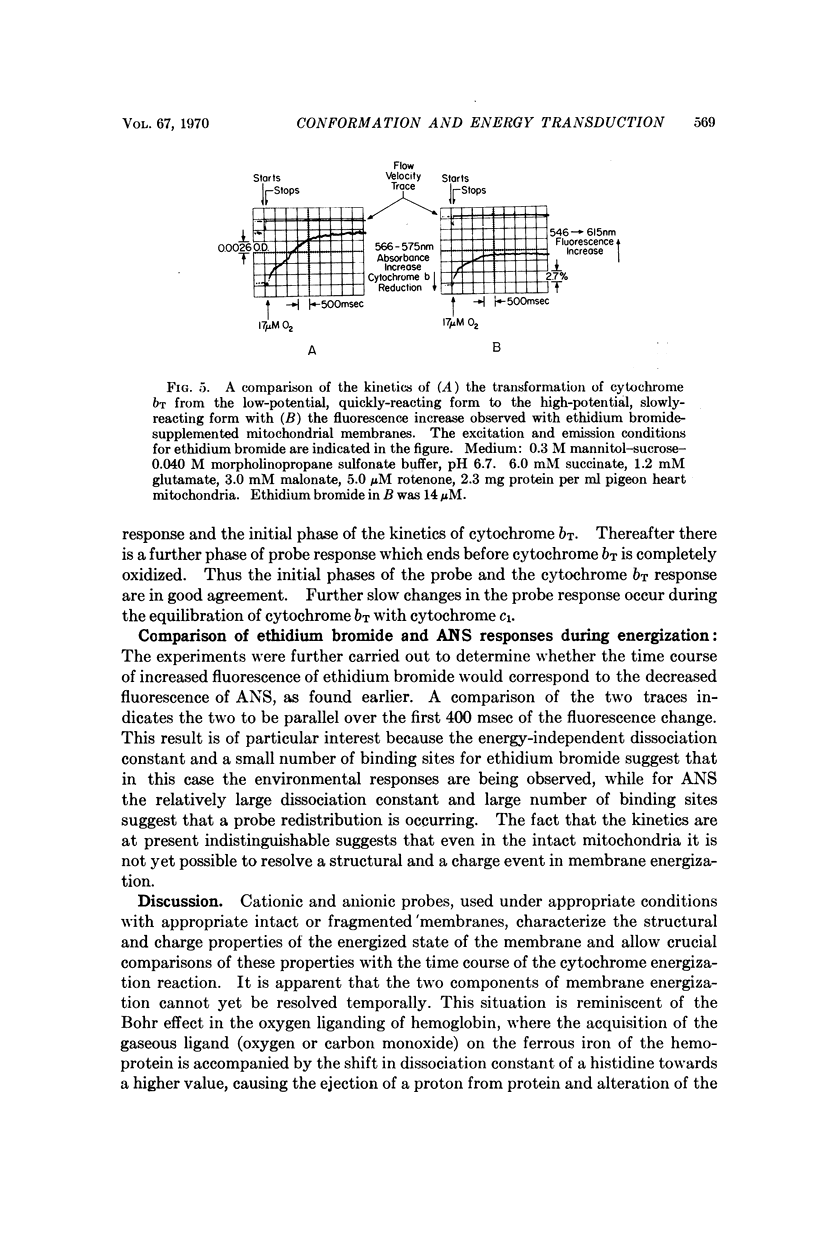
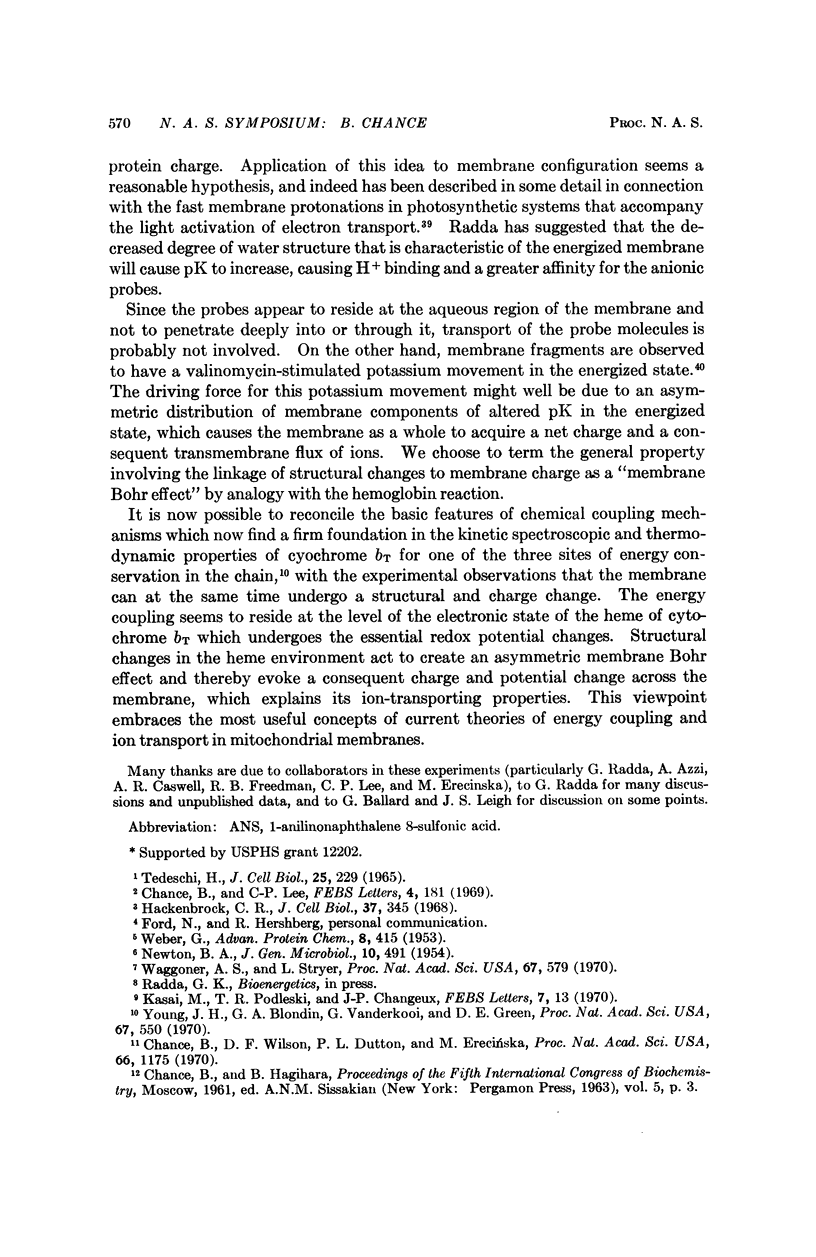
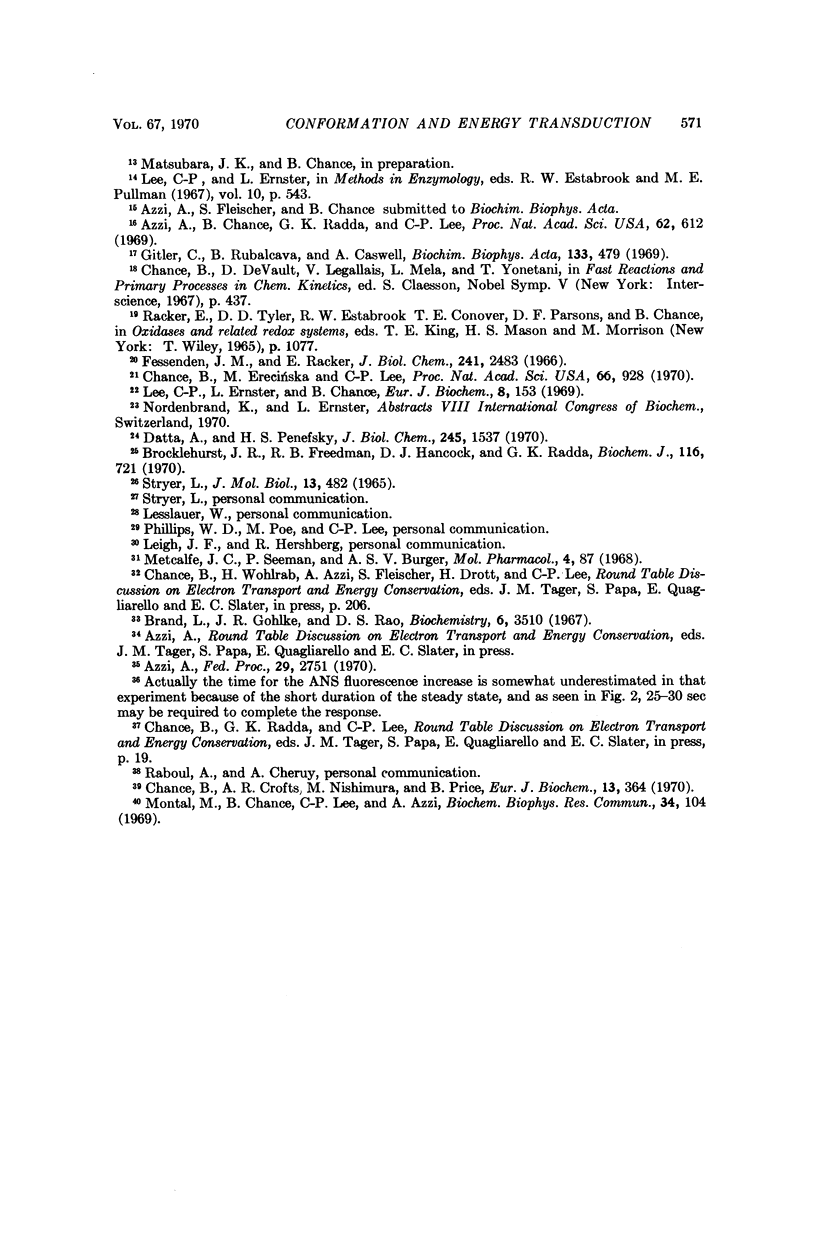
Selected References
These references are in PubMed. This may not be the complete list of references from this article.
- Azzi A., Chance B., Radda G. K., Lee C. P. A fluorescence probe of energy-dependent structure changes in fragmented membranes. Proc Natl Acad Sci U S A. 1969 Feb;62(2):612–619. doi: 10.1073/pnas.62.2.612. [DOI] [PMC free article] [PubMed] [Google Scholar]
- Brand L., Gohlke J. R., Rao D. S. Evidence for binding of rose bengal and anilinonaphthalenesulfonates at the active site regions of liver alcohol dehydrogenase. Biochemistry. 1967 Nov;6(11):3510–3518. doi: 10.1021/bi00863a024. [DOI] [PubMed] [Google Scholar]
- Brocklehurst J. R., Freedman R. B., Hancock D. J., Radda G. K. Membrane studies with polarity-dependent and excimer-forming fluorescent probes. Biochem J. 1970 Feb;116(4):721–731. doi: 10.1042/bj1160721. [DOI] [PMC free article] [PubMed] [Google Scholar]
- Chance B., Crofts A. R., Nishimura M., Price B. Fast membrane H+ binding in the light-activated state of Chromatium chromatophores. Eur J Biochem. 1970 Apr;13(2):364–374. doi: 10.1111/j.1432-1033.1970.tb00938.x. [DOI] [PubMed] [Google Scholar]
- Chance B., Erecińska M., Lee C. P. Localization of cytochromes in intact and fragmented mitochondrial membranes. Proc Natl Acad Sci U S A. 1970 Jul;66(3):928–935. doi: 10.1073/pnas.66.3.928. [DOI] [PMC free article] [PubMed] [Google Scholar]
- Chance B., Lee C. -p. Comparison of fluorescence probe and light-scattering readout of structural states of mitochondrial membrane fragments. FEBS Lett. 1969 Aug;4(3):181–184. doi: 10.1016/0014-5793(69)80229-2. [DOI] [PubMed] [Google Scholar]
- Chance B., Wilson D. F., Dutton P. L., Erecińska M. Energy-coupling mechanisms in mitochondria: kinetic, spectroscopic, and thermodynamic properties of an energy-transducing form of cytochrome b. Proc Natl Acad Sci U S A. 1970 Aug;66(4):1175–1182. doi: 10.1073/pnas.66.4.1175. [DOI] [PMC free article] [PubMed] [Google Scholar]
- Datta A., Penefsky H. S. Interaction of fluorescent probes with submitochondrial particles during oxidative phosphorylation. J Biol Chem. 1970 Apr 10;245(7):1537–1544. [PubMed] [Google Scholar]
- Fessenden J. M., Racker E. Partial resolution of the enzymes catalyzing oxidative phosphorylation. XI. Stimulation of oxidative phosphorylation by coupling factors and oligomycin; inhibition by an antibody against coupling factor 1. J Biol Chem. 1966 May 25;241(10):2483–2489. [PubMed] [Google Scholar]
- Gitler C., Rubalcava B., Caswell A. Fluorescence changes of ethidium bromide on binding to erythrocyte and mitochondrial membranes. Biochim Biophys Acta. 1969;193(2):479–481. doi: 10.1016/0005-2736(69)90208-9. [DOI] [PubMed] [Google Scholar]
- Hackenbrock C. R. Ultrastructural bases for metabolically linked mechanical activity in mitochondria. II. Electron transport-linked ultrastructural transformations in mitochondria. J Cell Biol. 1968 May;37(2):345–369. doi: 10.1083/jcb.37.2.345. [DOI] [PMC free article] [PubMed] [Google Scholar]
- Kasai M., Podleski T. R., Changeux J. -P. Some structural properties of excitable membranes labelled by fluorescent probes. FEBS Lett. 1970 Mar 16;7(1):13–19. doi: 10.1016/0014-5793(70)80605-6. [DOI] [PubMed] [Google Scholar]
- Lee C. P., Ernster L., Chance B. Studies of the energy-transfer system of submitochondrial particles. Kinetic studies of the effect of oligomycin on the respiratory chain of EDTA particles. Eur J Biochem. 1969 Mar;8(2):153–163. doi: 10.1111/j.1432-1033.1969.tb00509.x. [DOI] [PubMed] [Google Scholar]
- Metcalfe J. C., Seeman P., Burgen A. S. The proton relaxation of benzyl alcohol in erythrocyte membranes. Mol Pharmacol. 1968 Jan;4(1):87–95. [PubMed] [Google Scholar]
- Montal M., Chance B., Lee C. P., Azzi A. Effect of ion-transporting antibiotics on the energy-linked reactions of submitochondrial particles. Biochem Biophys Res Commun. 1969 Jan 6;34(1):104–110. doi: 10.1016/0006-291x(69)90535-x. [DOI] [PubMed] [Google Scholar]
- NEWTON B. A. Site of action of polymyxin on Pseudomonas aeruginosa: antagonism by cations. J Gen Microbiol. 1954 Jun;10(3):491–499. doi: 10.1099/00221287-10-3-491. [DOI] [PubMed] [Google Scholar]
- Stryer L. The interaction of a naphthalene dye with apomyoglobin and apohemoglobin. A fluorescent probe of non-polar binding sites. J Mol Biol. 1965 Sep;13(2):482–495. doi: 10.1016/s0022-2836(65)80111-5. [DOI] [PubMed] [Google Scholar]
- WEBER G. Rotational Brownian motion and polarization of the fluorescence of solutions. Adv Protein Chem. 1953;8:415–459. doi: 10.1016/s0065-3233(08)60096-0. [DOI] [PubMed] [Google Scholar]
- Waggoner A. S., Stryer L. Fluorescent probes of biological membranes. Proc Natl Acad Sci U S A. 1970 Oct;67(2):579–589. doi: 10.1073/pnas.67.2.579. [DOI] [PMC free article] [PubMed] [Google Scholar]
- Young J. H., Blondin G. A., Vanderkooi G., Green D. E. Conformational model of active transport. Proc Natl Acad Sci U S A. 1970 Oct;67(2):550–559. doi: 10.1073/pnas.67.2.550. [DOI] [PMC free article] [PubMed] [Google Scholar]


